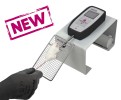Authors
HJ Kim, JH Lee, SW Kim et al
Lab
Gwangju Institute of Science and Technology, Gwangju, Jeollanam-do, Republic of Korea
Journal
PloS One
Abstract
Skeletal muscle atrophy is a feature of aging (termed sarcopenia) and various diseases, such as cancer and kidney failure. Effective drug treatment options for muscle atrophy are lacking. The tapeworm medication, niclosamide is being assessed for repurposing to treat numerous diseases, including end-stage cancer metastasis and hepatic steatosis. In this study, we investigated the potential of niclosamide as a repurposing drug for muscle atrophy. In a myotube atrophy model using the glucocorticoid, dexamethasone, niclosamide did not prevent the reduction in myotube diameter or the decreased expression of phosphorylated FOXO3a, which upregulates the ubiquitin-proteasome pathway of muscle catabolism. Treatment of normal myotubes with niclosamide did not activate mTOR, a major regulator of muscle protein synthesis, and increased the expression of atrogin-1, which is induced in catabolic states. Niclosamide treatment also inhibited myogenesis in muscle precursor cells, enhanced the expression of myoblast markers Pax7 and Myf5, and downregulated the expression of differentiation markers MyoD, MyoG and Myh2. In an animal model of muscle atrophy, niclosamide did not improve muscle mass, grip strength or muscle fiber cross-sectional area. Muscle atrophy is also feature of cancer cachexia. IC50 analyses indicated that niclosamide was more cytotoxic for myoblasts than cancer cells. In addition, niclosamide did not suppress the induction of iNOS, a key mediator of atrophy, in an in vitro model of cancer cachexia and did not rescue myotube diameter. Overall, these results suggest that niclosamide may not be a suitable repurposing drug for glucocorticoid-induced skeletal muscle atrophy or cancer cachexia. Nevertheless, niclosamide may be employed as a compound to study mechanisms regulating myogenesis and catabolic pathways in skeletal muscle.
BIOSEB Instruments Used:
Grip strength test (BIO-GS3)

 Pain - Thermal Allodynia / Hyperalgesia
Pain - Thermal Allodynia / Hyperalgesia Pain - Spontaneous Pain - Postural Deficit
Pain - Spontaneous Pain - Postural Deficit Pain - Mechanical Allodynia / Hyperalgesia
Pain - Mechanical Allodynia / Hyperalgesia Learning/Memory - Attention - Addiction
Learning/Memory - Attention - Addiction Physiology & Respiratory Research
Physiology & Respiratory Research
 Pain
Pain Metabolism
Metabolism Motor control
Motor control Neurodegeneration
Neurodegeneration Cross-disciplinary subjects
Cross-disciplinary subjects Muscular system
Muscular system General activity
General activity Mood Disorders
Mood Disorders Other disorders
Other disorders Joints
Joints Central Nervous System (CNS)
Central Nervous System (CNS) Sensory system
Sensory system
